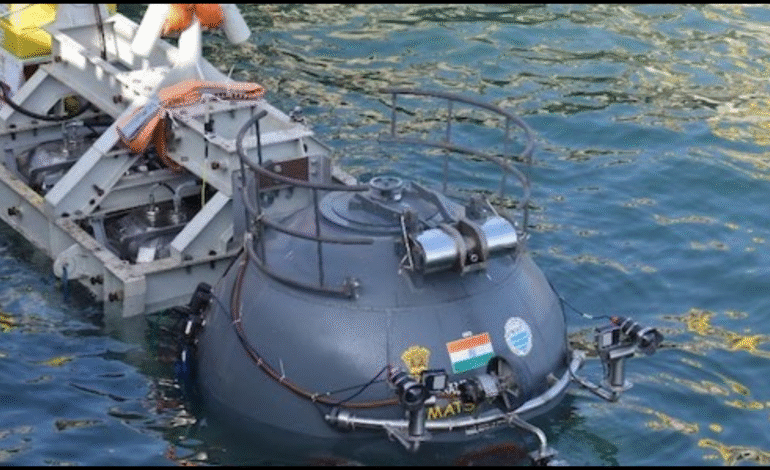ISRO Advances Deep-Sea Exploration with Samudrayaan Personnel Sphere Milestone

India’s ambitious deep-sea exploration project, Samudrayaan, has achieved a major technological milestone as the Indian Space Research Organisation (ISRO) successfully completed the first welding of the personnel sphere for the submersible vessel MATSYA-6000. This vessel is engineered to carry a human crew down to an incredible depth of 6,000 meters below sea level, pushing India to the forefront of deep-sea exploration technologies.
The National Institute of Ocean Technology (NIOT), under the Ministry of Earth Sciences (MoES), in collaboration with ISRO’s Vikram Sarabhai Space Centre (VSSC), has designed and fabricated this critical component—the personnel sphere—that will serve as the life-sustaining crew compartment of the submersible. This innovation is a defining step for India’s Deep Ocean Mission, which aims to expand scientific research and resource exploration in the largely uncharted Indian Ocean depths.
What is the Personnel Sphere? A Marvel of Engineering for Ocean Depths
The personnel sphere is a highly engineered pressure hull where the submersible crew will live and operate safely during deep-sea dives. The sphere itself measures 2.26 meters in diameter and is constructed from a titanium alloy renowned for its exceptional strength, light weight, and superior resistance to corrosion in the harsh marine environment.
Engineered to withstand extreme underwater pressures reaching 600 bar equivalent to nearly 6,000 meters of ocean depth the sphere’s walls are a remarkable 80 millimeters thick. This pressure resistance is critical to ensuring the safety of the three-member crew operating inside, while the vessel simultaneously endures cold ocean temperatures as low as -3°C.
The ability to create a pressure-resistant spherical crew compartment is a hallmark of cutting-edge deep-sea technology and places India among a select group of nations capable of fabricating such complex underwater habitats.
Overcoming Welding Challenges: ISRO’s Technological Breakthrough
One of the most formidable challenges in building the personnel sphere was welding extremely thick titanium plates (between 80 to 102 mm) to form a structurally sound and safe compartment.
To achieve this, ISRO’s Liquid Propulsion Systems Centre (LPSC) in Bengaluru upgraded its Electron Beam Welding (EBW) equipment from 15kW to 40kW capacity an enhancement crucial to fusing the thick titanium rings securely.
More than 700 welding trials were meticulously conducted to optimize process parameters, ensuring high structural integrity and quality without compromising safety. The actual welding of the full-scale sphere, measuring 7,100 millimeters long, was completed flawlessly in just 32 minutes, marking a first in the country’s engineering history.
Rigorous Quality Assurance: Ensuring Safety and Reliability
Beyond welding, ISRO enhanced its X-ray radiography capabilities, operating at some of the highest energy levels used in India, to carry out detailed, non-destructive evaluation (NDE) of the welds. This ensured no microscopic flaws or defects could jeopardize the crew’s safety under extreme conditions.
Advanced inspection techniques such as Time of Flight Diffraction (TOFD) and Phased Array Ultrasonic Testing (PAUT) were employed to detect even the smallest imperfections, guaranteeing the robustness and durability of the pressure hull.
Additionally, third-party certification agencies are reviewing the welding procedures and safety parameters to ensure full compliance with international safety standards, further bolstering confidence in the submersible’s design.
The Significance of the Samudrayaan Project
Samudrayaan, which means “Ocean Voyage,” represents India’s bold foray into deep-sea manned exploration, with multiple strategic goals:
- To enhance marine scientific research in the Indian Ocean
- To enable exploration of underwater resources, including rare minerals
- To foster technology development for underwater habitats and robotics
- To position India as a leader in blue economy initiatives
By successfully fabricating the personnel sphere, ISRO and NIOT are laying the technological foundation required for future manned dives to the deep ocean, potentially revolutionizing underwater science and industry in the region.
Collaboration Between NIOT and ISRO: Pioneering India’s Oceanic Frontier
The partnership between the National Institute of Ocean Technology and ISRO’s Vikram Sarabhai Space Centre exemplifies the power of interdisciplinary collaboration. NIOT brought its oceanographic expertise and design insights, while ISRO contributed cutting-edge space engineering, precision fabrication, and advanced welding technologies.
This synergy has yielded a state-of-the-art human-occupied vehicle (HOV) capable of withstanding the extreme pressures and temperatures of the deep ocean, ensuring crew safety and mission success.
What’s Next for Samudrayaan?
With the personnel sphere fabrication complete, the Samudrayaan project is rapidly progressing towards launching manned exploratory missions to the deep Indian Ocean. Future phases will integrate life support systems, propulsion, navigation, and scientific instrumentation onboard MATSYA-6000.
These missions are expected to open new avenues in:
- Marine biodiversity studies
- Seafloor mapping and geological surveys
- Resource identification such as polymetallic nodules and rare earth elements
- Technological innovations in underwater robotics and communication
For the UAE and the wider Middle East region, advancements in deep-sea exploration technology resonate strongly with their interest in maritime research, sustainable resource use, and oceanic security.
Why This Development Matters Globally
Only a few countries possess the technical capability to build deep-sea human habitats capable of diving thousands of meters beneath the ocean surface. India’s breakthrough in fabricating the personnel sphere places it alongside global leaders like the USA, Japan, and Russia.
This technological achievement not only strengthens India’s strategic capabilities in ocean science but also opens doors for international collaboration in oceanographic research and resource management.
A Giant Leap for Indian Ocean Exploration
The successful fabrication and welding of the personnel sphere for the Samudrayaan mission marks a watershed moment for India’s deep-sea ambitions. The union of space-grade engineering from ISRO and oceanographic expertise from NIOT has created a robust, safe environment for manned underwater exploration at depths never before attempted by the country.
As the project moves toward full deployment, it signals India’s emergence as a leader in deep-sea technology and blue economy development a development watched closely by maritime nations worldwide, including the UAE and Middle East.
The Samudrayaan mission exemplifies the future of human exploration, where the ocean depths become the new frontier alongside space.







